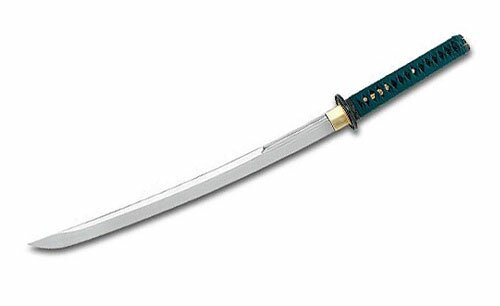

The blades are rested between passes to prevent them from becoming hot and damaging their temper.

The process involves many passes with sanding belts of various grits. The sharpening service is done with a belt sander. We adjust the angle of the edge to suit the specific blade and attempt to get as close to a bevel-less edge as possible without marring the surface of the blade. Some blades will take and hold sharper edges than others and the thickness of the blade will determine how wide the bevel will need to be. The resulting edge is somewhat dependent on the particular blade. The result is typically “very sharp” with a small secondary bevel and a bit of an “apple seed” profile. Our sharpening service will provide a good serviceable edge on the blade. Consider this as a general guideline only. The Edge ratings in particular are somewhat subjective and each blade can vary. This info is provided to give you a good idea of the product being presented, the one you receive may vary from the specific one we took measurements of. Please note: Due to the hand made nature of these items, all specs should be considered as approximates. However for reasons we won’t get into here, this is not the case. A common misconception is that swords should all be “razor sharp”. Moderately Sharp is close, but may need to be touched up to get the best performance. Possible values could be “Rebated” meaning the edge is intentionally thickened for safety, “Blunt” meaning the edge is fairly thick with little to no taper, ‘Unsharpened” which would taper to the edge but stop short of having any real cutting ability, “Slightly Sharp, Moderately Sharp, Sharp, or Very Sharp” Sharp or Very Sharp are considered good for cutting swords. The “Edge” spec will tell you about how sharp a blade is.

A very high POB will result in a sword that feels heavier than it actually is and is difficult to wield. In general, a low POB results in good point control well suited to a thrusting blade, while a higher POB adds impact to a cleaving blade. A POB of 3”- 5” usually results in a well balanced sword, but does depend on the type of sword. In practice however, there are many reasons why you may not want this for a particular sword. In theory a sword with a POB of 0” is perfectly balanced. A number of 0” would balance exactly at the guard, while a negative number will have a POB in the hilt itself. It refers to the point on the blade where the sword achieves a perfect balance.

stands for Point Of Balance, this is measured in inches from the hilt down the blade. Not exactly the same in every case, but there are many similarities.P.O.B. Here's a couple of videos that give you a rough idea how some protection katana are made. In other words, the tsuka dies not meet the Tang until it's to be assembled.īut it's not like ordering car parts where even an aftermarket maker will make a part down to a fraction of a millimeter tolerance to comply with the standards of the original part.īut once again, I thought Cold Steel had a better standards than that. The tangs are made a general size by whoever is making the blade and a third party would be making the tsukas to roughly the same general size.Īnd like marriages that used to be arranged, the bride and groom here don't meet until the wedding day. Most production swords are not made to fit their component parts. So if the tsuka is broken now, it's most likely because it was put on a Tang that was too large for it (or it was made too small for, depending on how you want to look at it) and it was stressed by that. However, I thought cold steel swords were more find finished than any of that.īut the marks you see on the Tang is where they had to file it down in order to get the tsuka to fit. What is more, is it the tsuka is made too small the point where it has to be hammered which sometimes causes a crack.
#Are cold steel katana swords marked pro#
Here is a link to my Ronin Dojo Pro Tanto as well as one of my Hanbon swords where you can see examples of that.Īlthough that is less common with most production swords. It's not uncommon for certain sword producers to use a putty-like filler to make sure everything is tight. Nothing should break when you try to disassemble a $/€600 sword.Īnd what do you it has no TAG on the blade? First off, and I'm sure you've already done this, contact Cold Steel.


 0 kommentar(er)
0 kommentar(er)
